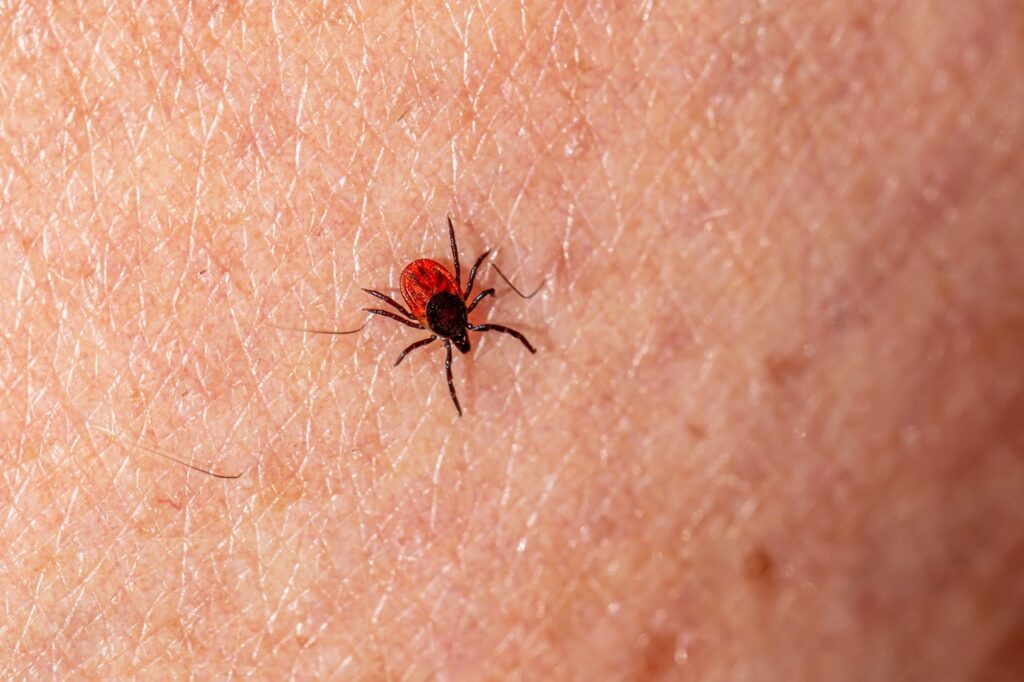
Written by Dr. Diane Mueller
Lyme disease is caused by an infection with one of several species of a bacteria called Borrelia. It is best to catch and treat early in order to work to avoid long term negative impacts of chronic Lyme Disease.
It is very common for early signs of Lyme Disease to go unnoticed because often times symptoms are nonexistent or resemble the flu.

Historically it was thought that we only had to be concerned about contracting Lyme disease in heavily forested areas. Now we know there is Lyme Disease in parks in major cities, making it much more common to contract than originally thought. Therefore, if you have any of the following symptoms of Lyme Disease, take them seriously even if you are not living in an area that is classically thought to be a Lyme area.
Infected ticks are carried as larvae in songbirds. As songbirds fly, they drop their feces (Yep – Gross!) carrying the infected ticks onto the earth. While this is a gross, the point is that it shows how Lyme Disease is traveling easily and spreading throughout the world.
Classic Early Lyme Disease Symptoms
To learn more about the specifics of the bullseye-shaped rash, you can see our blog called Lyme Disease Bullseye Rash. The most important thing to be aware of is that this rash is not present in a large number of individuals. Too many people do not consider that they have contracted Lyme Disease simply due to a lack of the presence of this rash post-tick bite.
It is also important to know that most of these symptoms tend to be self-limiting initially. This means that symptoms can go away on their own. The problem with this is that people often think this means that their body has cleared the infection. This could not be further from the truth. Lyme Disease is not like getting a cold or a flu. Borrelia infection can be driven deeper into the tissues and the infection can become dormant for a period. When the infection is dormant, symptoms typically go away. But Borrelia can become reactivated. When it is reactivated, Borrelia tends to take on different symptoms. The longer-term symptoms of Borrelia can be more difficult to pinpoint as Lyme Disease. You can read more about this on our blog Chronic Lyme Disease Symptoms.
Therefore, if you know you have been bitten by a tick, it is a good idea to assume you have contracted some sort of infection. (We say some sort here because ticks carry a wide variety of diseases. You could be infected with Borrelia and get Lyme but you could also be infected by a whole host of other microorganisms as well). Proper testing for tickborne diseases is always important post tick bite to be able to best identify if you have picked up any disease. Some people do not have any of the early Lyme Disease symptoms and without proper testing, Borrelia could be in dormancy for years or decades until it wakes up and manifests as chronic Lyme Disease. All of this can be largely avoided if you are properly testing for Lyme Disease post exposure.
Van Hout MC. The Controversies, Challenges and Complexities of Lyme Disease: A Narrative Review. J Pharm Pharm Sci. 2018;21(1):429-436. doi: 10.18433/jpps30254. PMID: 30458921.
Radolf JD, Strle K, Lemieux JE, Strle F. Lyme Disease in Humans. Curr Issues Mol Biol. 2021;42:333-384. doi: 10.21775/cimb.042.333. Epub 2020 Dec 11. PMID: 33303701; PMCID: PMC7946767.
We have helped thousands of
people restore their health
and quality of life by diagnosing
and treating their Lyme Disease.
“Dr. Mueller’s approach to medicine is refreshing! There is only so much you can do with western medicine and in my life I was needing a new approach. By addressing the whole body, nutritional diet factors, environmental factors, blood work, and incorporating ideas I had not previously known, I was able to break through with my conditions. I am not only experiencing less pain in my life, but through the process of healing guided by Dr. Diane Mueller, I am now happy to say I have more consciousness surrounding how I eat, what to eat and when things are appropriate. Living by example Dr. Mueller has a vibrancy that makes you want to learn and know more about your body and overall health. I highly recommend her to anyone looking for new answers, a new approach to health, or in need of freedom from pain and limitations.”
-Storie S.
Kihei, HI
